
Henry VII was King of England and Lord of Ireland from his seizure of the crown on 22 August 1485 until his death in 1509. He was the first monarch of the House of Tudor.
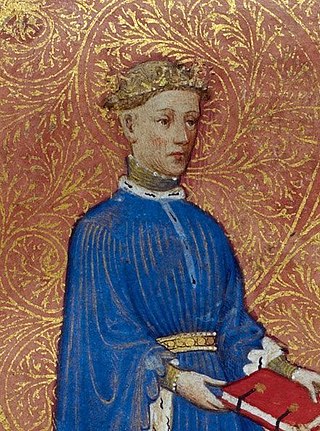
Henry V, also called Henry of Monmouth, was King of England and Lord of Ireland from 1413 until his death in 1422. Despite his relatively short reign, Henry's outstanding military successes in the Hundred Years' War against France made England one of the strongest military powers in Europe. Immortalised in Shakespeare's "Henriad" plays, Henry is known and celebrated as one of the greatest warrior-kings of medieval England.

Henry VI was King of England and Lord of Ireland from 1422 to 1461 and again from 1470 to 1471, and disputed King of France from 1422 to 1453. The only child of Henry V, he succeeded to the English throne at the age of nine months upon his father's death, and succeeded to the French throne on the death of his maternal grandfather, Charles VI, shortly afterwards.

The Royal Pavilion, and surrounding gardens, also known as the Brighton Pavilion, is a Grade I listed former royal residence located in Brighton, England. Beginning in 1787, it was built in three stages as a seaside retreat for George, Prince of Wales, who became the Prince Regent in 1811, and King George IV in 1820. It is built in the Indo-Saracenic style prevalent in India for most of the 19th century. The current appearance of the Pavilion, with its domes and minarets, is the work of architect John Nash, who extended the building starting in 1815. George IV's successors William IV, and Victoria, also used the Pavilion, but Queen Victoria decided that Osborne House should be the royal seaside retreat, and the Pavilion was sold to the city of Brighton in 1850.
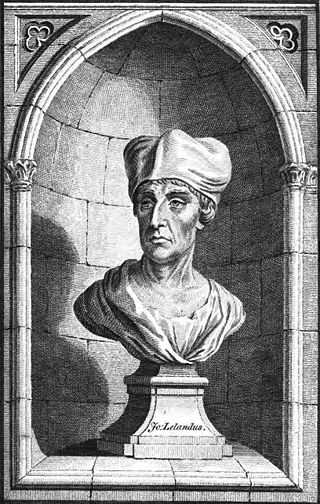
John Leland or Leyland was an English poet and antiquary.

Francis II was Duke of Brittany from 1458 to his death. He was the grandson of John IV, Duke of Brittany. A recurring theme in Francis' life would be his quest to maintain the quasi-independence of Brittany from France. As such, his reign was characterized by conflicts with King Louis XI of France and with his daughter, Anne of France, who served as regent during the minority of her brother, King Charles VIII. The armed and unarmed conflicts from 1465 to 1477 and 1484–1488 have been called the "War of the Public Weal" and the Mad War, respectively.

From the 1340s to the 19th century, excluding two brief intervals in the 1360s and the 1420s, the kings and queens of England and Ireland also claimed the throne of France. The claim dates from Edward III, who claimed the French throne in 1340 as the sororal nephew of the last direct Capetian, Charles IV. Edward and his heirs fought the Hundred Years' War to enforce this claim, and were briefly successful in the 1420s under Henry V and Henry VI, but the House of Valois, a cadet branch of the Capetian dynasty, was ultimately victorious and retained control of France, except for Calais and the Channel Islands. English and British monarchs continued to prominently call themselves kings of France, and the French fleur-de-lis was included in the royal arms. This continued until 1801, by which time France no longer had any monarch, having become a republic. The Jacobite claimants, however, did not explicitly relinquish the claim.

Hertford Castle was built in Norman times by the River Lea in Hertford, the county town of Hertfordshire, England. Most of the internal buildings of the castle have been demolished. The main surviving section is the Tudor gatehouse, which is a Grade I listed building. Parts of the bailey walls on the east side of the castle also still stand, and are a Grade II* listed building.
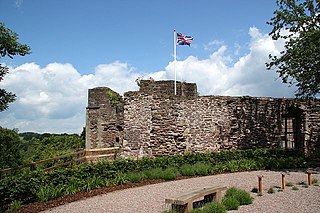
Monmouth Castle is a castle close to the centre of the town of Monmouth, the county town of Monmouthshire, on a hill above the River Monnow in south east Wales.
George Weare Braikenridge (1775–1856) was an English antiquarian. He was born in the Colony of Virginia, but lived for most of his life in Bristol, England, where he created a large collection of Bristolian historical and topographical material known as the Braikenridge Collection. It contains over 1400 drawings and watercolours of Bristol landscapes and buildings. These are held in Bristol City Museum and Art Gallery, with related collections of manuscripts and other items held by Bristol Central Library and Bristol Archives. The Braikenridge Collection has become the most important historical record of Bristol's appearance in the early 19th century, and makes Bristol one of the best documented English cities in this respect.
Hugh O'Neill (1784–1824) was an English architectural and antiquarian draughtsman who contributed 441 drawings of scenes from Bristol, England to the topographical collection of George Weare Braikenridge. The Braikenridge Collection makes Bristol's early 19th century appearance one of the best documented of any English city.
Thomas Leeson Scrase Rowbotham (1782–1853) was an English watercolourist and oil painter. He was a skilled painter of landscapes and marine subjects, became professor of drawing at the Royal Naval School and produced books on painting and drawing. He contributed 258 watercolours of scenes from Bristol, England to the topographical collection of George Weare Braikenridge. The Braikenridge Collection makes Bristol's early 19th century appearance one of the best documented of any English city.

The Wars of the Roses (1455–1487), known at the time and for more than a century after as the Civil Wars, were a series of civil wars fought over control of the English throne in the mid-to-late fifteenth century. These wars were fought between supporters of two rival cadet branches of the royal House of Plantagenet: Lancaster and York. The wars extinguished the male lines of the two branches, leading to the Tudor family inheriting the Lancastrian claim to the throne. Following the war, the Houses of Lancaster and York were united, creating a new royal dynasty and thereby resolving their rival claims. For over thirty years, there were greater and lesser levels of violent conflict between various rival contenders for control of the English monarchy.

Mark Noble (1754–1827) was an English clergyman, biographer and antiquary.
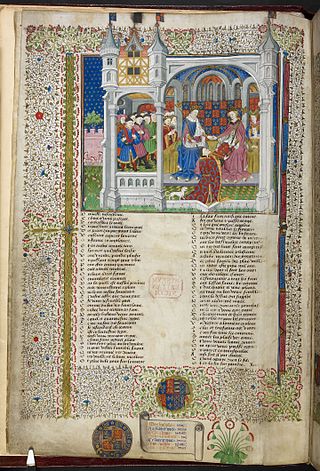
The Royal manuscripts are one of the "closed collections" of the British Library, consisting of some 2,000 manuscripts collected by the sovereigns of England in the "Old Royal Library" and given to the British Museum by George II in 1757. They are still catalogued with call numbers using the prefix "Royal" in the style "Royal MS 2. B. V". As a collection, the Royal manuscripts date back to Edward IV, though many earlier manuscripts were added to the collection before it was donated. Though the collection was therefore formed entirely after the invention of printing, luxury illuminated manuscripts continued to be commissioned by royalty in England as elsewhere until well into the 16th century. The collection was expanded under Henry VIII by confiscations in the Dissolution of the Monasteries and after the falls of Henry's ministers Cardinal Wolsey and Thomas Cromwell. Many older manuscripts were presented to monarchs as gifts; perhaps the most important manuscript in the collection, the Codex Alexandrinus, was presented to Charles I in recognition of the diplomatic efforts of his father James I to help the Eastern Orthodox churches under the rule of the Ottoman Empire. The date and means of entry into the collection can only be guessed at in many if not most cases. Now the collection is closed in the sense that no new items have been added to it since it was donated to the nation.

Georgiana, Lady Llangattock,, born Georgiana Marcia Maclean and after her marriage termed Georgiana Marcia Rolls, was a socialite, benefactor and an enthusiast for Horatio Nelson and associated naval heroes. She was the wife of John Rolls, 1st Baron Llangattock, a Victorian landowner, Member of Parliament and agriculturalist. She and her husband lived at The Hendre, a Victorian country house north of Monmouth.

The Monmouth Alms Houses of Monmouth, Wales are funded by the charity established by the haberdasher William Jones before his death in 1615. That charity also established schools in Monmouth and a lectureship in London. The Haberdashers' Company served as trustee of the charity from 1613 until 2011, when the trusteeship was transferred to Bristol Charities. A second charity established through a separate bequest by Jones enabled the building of the Newland Alms Houses in the Forest of Dean. The original Monmouth Alms Houses were constructed in 1614; they were rebuilt in 1842 and 1961. The fourth version of the Monmouth Alms Houses was completed in 2013 and is named 'Cwrt William Jones Almshouses' and is owned and managed by Bristol Charities under the name of 'William Jones Almshouse Charity'. The original alms houses were located on what is now known as Almshouse Street. The most recent houses are located off St James' Square.

The marriage bed of Henry VII is a carved oak four-post bedstead bought in a dilapidated condition at an auction in Chester, England, in 2010. Since then it has received considerable publicity in various media and is claimed by its supporters to be the bed designed and built for use on the night of King Henry VII's marriage to Elizabeth of York on 18 January 1486. The marriage symbolised the end of the War of the Roses by joining Henry's House of Lancaster to Elizabeth's House of York and the bed's design reflected this featuring both the White Rose of York and the Red Rose of Lancaster. A carving on the headboard depicted the Royal couple as either Adam and Eve or Christ and the Virgin Mary defeating the animals that opposed Christ in Psalm 91 and bringing paradise to England. The bed also includes the arms of France, reflecting Henry's possessions and ambitions there, as well as religious and fertility symbols.
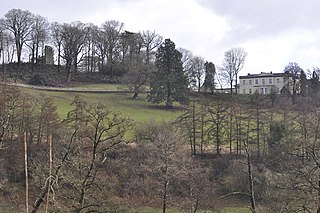
Courtfield, Welsh Bicknor, Herefordshire, England is a country house dating from the early 19th century. The present building stands on the site of a much older mansion which, according to tradition, was home to Henry V for the early years of his life. This house was originally called Greenfield or Greyfield but was renamed Courtfield at that time. Nothing now remains of that building and the present house was erected in the very early 19th century by William Michael Vaughan. The Vaughans had purchased the estate in the 16th century. Staunchly Roman Catholic, and much persecuted in the 17th and 18th centuries; in the mid-19th century Herbert Vaughan, later a cardinal and Archbishop of Westminster, was brought up at the house, born into a large family, an unusually high number of whom entered the church. In 1950 Courtfield was sold by Patrick Vaughan to the Mill Hill Missionaries who ran a House of Formation at the house. In 2010, the mission was closed and the house sold back to the Vaughan family, who had retained ownership of the wider estate. Courtfield is a Grade II listed building. The house is not open to the public.

















